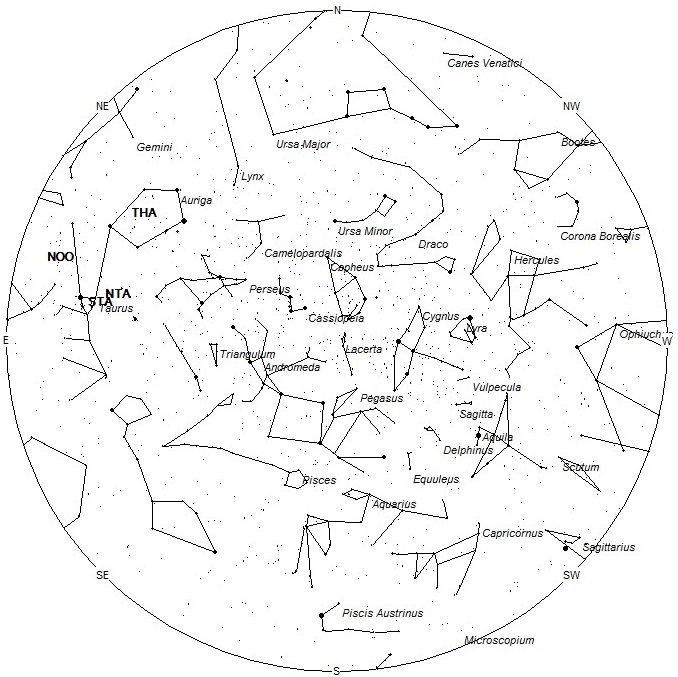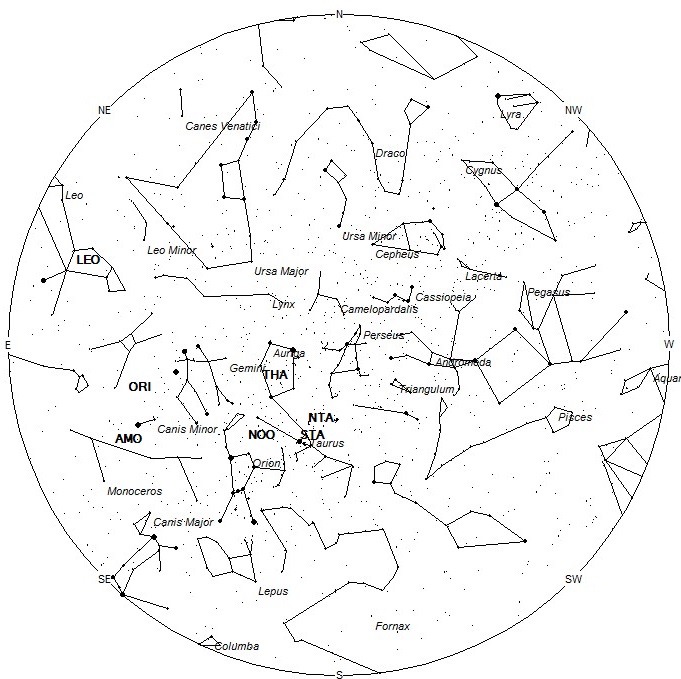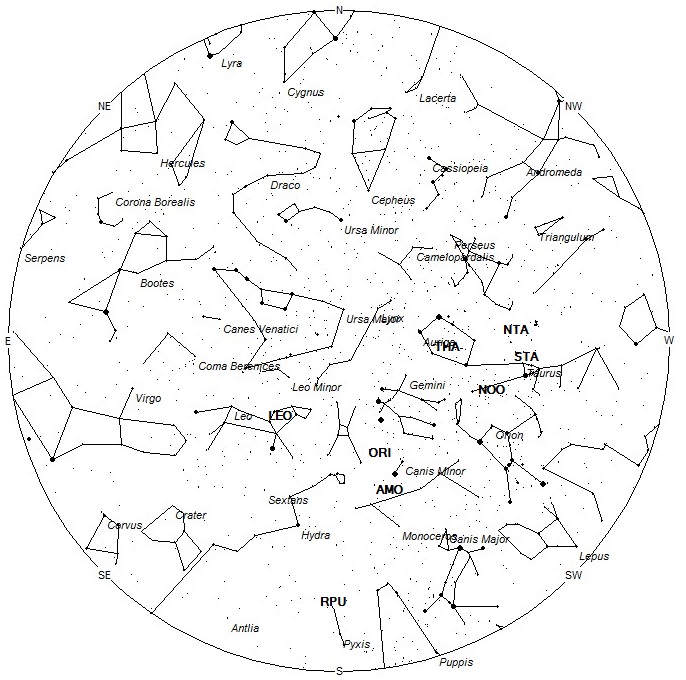During this period the moon reaches its last quarter phase on Tuesday November 19th. At this time the moon will be located 90 degrees west of the sun and will rise near 0200 local standard time. This weekend the waning gibbous moon will rise just before midnight, ruining the sky for meteor observers the remainder of the night. Only late in the period will the moon allow meteor observers to achieve decent limiting magnitudes during the morning hours. One could always view during the moonless evening hours but rates are low at this time. The estimated total hourly meteor rates for evening observers this week is near 3 for those viewing from the southern hemisphere and 4 for those located north of the equator. For morning observers the estimated total hourly rates should be near 6 as seen from tropical southern locations (25S) and 9 as seen from mid-northern latitudes (45N). The actual rates will also depend on factors such as personal light and motion perception, local weather conditions, alertness and experience in watching meteor activity. Morning rates are reduced due to moonlight. Note that the hourly rates listed below are estimates as viewed from dark sky sites away from urban light sources. Observers viewing from urban areas will see less activity as only the brightest meteors will be visible from such locations.
The radiant (the area of the sky where meteors appear to shoot from) positions and rates listed below are exact for Saturday night/Sunday morning November 16/17. These positions do not change greatly day to day so the listed coordinates may be used during this entire period. Most star atlases (available at science stores and planetariums) will provide maps with grid lines of the celestial coordinates so that you may find out exactly where these positions are located in the sky. A planisphere or computer planetarium program is also useful in showing the sky at any time of night on any date of the year. Activity from each radiant is best seen when it is positioned highest in the sky, either due north or south along the meridian, depending on your latitude. It must be remembered that meteor activity is rarely seen at the radiant position. Rather they shoot outwards from the radiant so it is best to center your field of view so that the radiant lies at the edge and not the center. Viewing there will allow you to easily trace the path of each meteor back to the radiant (if it is a shower member) or in another direction if it is a sporadic. Meteor activity is not seen from radiants that are located below the horizon. The positions below are listed in a west to east manner in order of right ascension (celestial longitude). The positions listed first are located further west therefore are accessible earlier in the night while those listed further down the list rise later in the night.
These sources of meteoric activity are expected to be active this week.
The Northern Taurids (NTA) are active from a large radiant located at 04:18 (064) +25. This area of the sky is located in northern Taurus, 5 degrees east of the naked eye star cluster known as the Pleiades. This position is close to the Southern Taurids so care must be taken in separating these meteors. You should have the two radiants near the center of your field of view to properly differentiate these sources. Current rates should be 2 per hour as seen from mid-northern latitudes and 1 per hour as seen from south tropical latitudes (25S). These meteors may be seen all night long but the radiant is best placed near 0200 LST when it lies on the meridian and is located highest in the sky. With an entry velocity of 28 km/sec., the average Northern Taurid meteor would be of slow velocity.
The Southern Taurids (STA) are active from a large radiant centered near 04:27 (067) +18. This position lies in central Taurus, 2 degrees northwest of the bright orange star known as Aldebaran (alpha Tauri). These meteors may be seen all night long but the radiant is best placed near 0200 LST when it lies on the meridian and is located highest in the sky. Hourly rates at this time should be near 1 for observers in the northern hemisphere and less than 1 for observers south of the equator. With an entry velocity of 27 km/sec., the average Southern Taurid meteor would be of slow velocity.
The November Orionids (NOO) are active from a radiant located at 05:16 (079) +16. This area of the sky lies on the Taurus/Orion border, 8 degrees east of the bright orange star known as Aldebaran (alpha Tauri). This radiant is best placed in the sky near 0300 LST, when it lies highest above the horizon. This stream is active from November 7 through December 17, with maximum activity occurring on November 29. Rates should be near 1 per hour no matter your location. With an entry velocity of 43 km/sec., most activity from this radiant would be of medium speed.
The November theta Aurigids (THA) were discovered by Dr. Peter Brown using the Canadian Meteor Orbit Radar. This stream is active from November 17 through December 1, with maximum activity occurring on November 26. The radiant currently lies at 05:40 (085) +35, which places it in central Auriga, 4 degrees southwest of the 3rd magnitude star known as Mahasim (theta Aurigae A). This area of the sky is best placed in the sky near 0200 LST, when it lies highest above the horizon in a dark sky. Rates should be less than 1 per hour no matter your location. With an entry velocity of 33 km/sec., most activity from this radiant would be of medium-slow velocity. These meteors are expected to be faint and may be difficult to observe unless viewing conditions are near optimum.
The alpha Monocerotids (AMO) are a shower of variable strength capable of outbursts, but usually very quiet. Activity may be seen for a week centered on November 22, but activity is usually limited to November 21-23. Maximum activity this year is expected near 04:50 UT on November 22, when an outburst from this source is possible. Maximum rates are unknown but during the last outburst in 1995, ZHR’s reached 400 for a short time. The radiant lies at 07:47 (117) +01. This area of the sky lies in southeastern Canis Minor, 4 degrees southeast of the brilliant zero magnitude star known as Procyon (alpha Canis Minoris). This radiant is best placed in the sky near 0400 LST, when it lies highest above the horizon in a dark sky. With an entry velocity of 63 km/sec., most activity from this radiant would be of swift velocity.
The Orionids (ORI) reached maximum activity on October 22nd but are still weakly active from a radiant located at 08:11 (123) +14, which places it in western Cancer, 5 degree northwest of the 4th magnitude star known as Tarf (beta Cancri). Rates should be less than 1 per hour no matter your location. With an entry velocity of 67 km/sec., most activity from this radiant would be of swift speed.
The rho Puppids (RPU) were discovered by Damir Šegon and the Croatian Meteor Network team based on studying SonotaCo and CMN observations (SonotaCo 2007-2011, CMN 2007-2010). These meteors are active from November 10-20 with maximum activity occurring on the 14th. The current position of this radiant is 08:51 (133) -27. This area of the sky lies in central Pyxis, 1 degree north of the 4th magnitude star known as gamma Pyxidis. These meteors are best seen during the last dark hour prior to dawn when it lies highest in a dark sky. Rates are expected to be less than 1 per hour no matter your location. With an entry velocity of 58 km/sec., most activity from this radiant would be of swift velocity.
The Leonids (LEO) peak this weekend with a possibility of a weak outburst occurring at 02:35 Universal Time (UT) on November 16th. This outburst is estimated to have a zenith hourly rate (ZHR) of 30 for a short time near maximum activity and is caused by particles from the 1400 return of comet 55P Temple-Tuttle. Another weaker outburst from the 1866 return is predicted at 13:35 UT with a maximum ZHR of 19. The annual Leonids are predicted to peak near 05:00 UT on November 18th from a radiant located at 10:15 (154) +22. This position lies within the “sickle” of Leo, just 1 degree northwest of the 3rd magnitude star known as Adhafera (zeta Leonis). The Leonid radiant is best placed during the last hour before morning twilight when the radiant lies highest in a dark sky. Leonids may be seen from the southern hemisphere but the viewing conditions are not quite as favorable as those north of the equator. With an entry velocity of 70 km/sec., most activity from this radiant would be of swift speed with numerous persistent trains on the brighter meteors.
As seen from the mid-northern hemisphere (45N) one would expect to see approximately 9 sporadic meteors per hour during the last hour before dawn as seen from rural observing sites. Evening rates would be near 3 per hour. As seen from the tropical southern latitudes (25S), morning rates would be near 6 per hour as seen from rural observing sites and 2 per hour during the evening hours. Locations between these two extremes would see activity between the listed figures. Evening rates are reduced due to moonlight.
The list below offers the information from above in tabular form. Rates and positions are exact for Saturday night/Sunday morning except where noted in the shower descriptions.
| SHOWER | DATE OF MAXIMUM ACTIVITY | CELESTIAL POSITION | ENTRY VELOCITY | CULMINATION | HOURLY RATE | CLASS |
| RA (RA in Deg.) DEC | Km/Sec | Local Standard Time | North-South | |||
| Northern Taurids (NTA) | Nov 03 | 04:18 (064) +25 | 28 | 00:00 | 2 – 1 | II |
| Southern Taurids (STA) | Oct 29 | 04:27 (067) +18 | 27 | 00:00 | 1 – <1 | II |
| November Orionids (NOO) | Nov 29 | 05:16 (079) +16 | 43 | 01:00 | 1 – 1 | II |
| November theta Aurigids (THA) | Nov 26 | 05:40 (085) +35 | 33 | 01:00 | <1 – <1 | IV |
| alpha Monocerotids (AMO) | Nov 22 | 07:47 (117) +01 | 63 | 03:00 | ? | III |
| Orionids (ORI) | Oct 22 | 08:11 (123) +14 | 67 | 04:00 | <1 – <1 | I |
| rho Puppids (RPU) | Nov 14 | 08:51 (133) -27 | 62 | 05:00 | 1 – <1 | IV |
| Leonids (LEO) | Nov 18 | 10:15 (154) +22 | 70 | 06:00 | Var. | I |
Reference
Maslov, Mikhail, Leonids 2019 – possible activity enhancements. https://www.emeteornews.net/2019/11/13/leonids-2019-possible-activity-enhancements/
Accessed 13 November 2019




